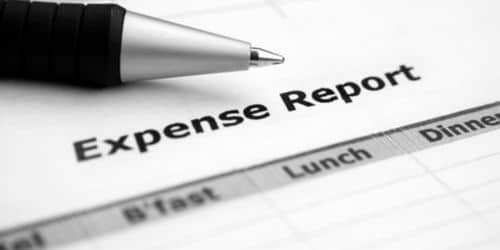Employees in any firm may incur business expenses that they must pay for out of their own pockets. This includes everything from travel fees and client luncheons to office supplies and technological gear. Employees will file an expense report to request reimbursement for any amount they paid because these expenses are incurred on behalf of the company. This article will teach you all you need to know about expense summary reports, including what they contain, why they are necessary, and, most importantly, how to fill out this report using software and a template.
An expense report is a categorized and itemized list of expenses incurred on the organization’s behalf. This report assists the employer or finance team in determining how much money was spent, what was purchased, and how much of the cost is reimbursed. The benefits of expense reports, however, are not limited to reimbursement claims. They also make it simpler for firms to file tax returns, claim tax deductions, and complete audits.
What is an Expense Report?
When an employee claims reimbursement for company expenses they paid for with their own money, these expenses are outlined on a paper or digital document called an expense report. These expenses are typically arranged by categories, such as office supplies, lunches, or mileage. They are additionally itemized so that several entities and their charges are listed. This enables more granular audits during the approval process rather than simply stating the overall amount of expenses incurred. The associated receipts for each itemized transaction are typically included in the expense report.
What is Included in an Expense Summary Report?
Expense reports come in a variety of formats. Many are cumulative, displaying total spending for a firm or department over a specified period (a month, quarter, or year, for example). Expense reports can also be more detailed, outlining individual expenses for a specific employee or project. These reports consist of:
- The date the expense was paid
- Whether the expense can be attributed to a certain client or project.
The payee or vendor the money went to - The entire amount paid, including taxes, commissions, and fees
- The expense category or type
Reports may include notes regarding the overall amount paid or specific items, such as why the cost was incurred or any subsequent projected costs linked to the same client or project, in addition to these superficial details.
Why Expense Reports Are Necessary
Expense reports are significant because they allow managers to track the company’s or a specific department or team’s expenditure – particularly costs associated with a specific customer or project.
In addition to assisting management, expense reports allow employees to be compensated for out-of-pocket business expenses such as travel or entertaining clients or potential clients.
Expense reports are frequently used for the following purposes:
- Monitoring department and business spending as well as an overall cash flow
- Deducting expenses from gross revenue to calculate profits
- Paying employees for legitimate business expenses
- Keeping track of expenses associated with a product line, a particular project, or a customer
Expense reports are used for a variety of objectives by different businesses. Consultants and lawyers, for example, frequently utilize these reports to track spending tied to a certain client, whereas manufacturing organizations manage expenses related to specific product lines. They are used by sales representatives to report and get reimbursed for travel and entertainment expenses.
What Is a Monthly Expense Report?
Expense reports are typically issued on a monthly, quarterly, or yearly basis. A monthly expense report lists all of the necessary purchases made by a company over the month.
To deduct expenses from a company’s taxes, a yearly expense report is frequently employed. A monthly expense report would therefore be utilized for additional purposes, such as determining if a company’s spending is within its budget. A monthly expense report can be used to determine how costs can be reduced or eliminated to increase profit in times of financial trouble.
What is Considered an Expense?
Any time a business representative spends money for a commercial objective, it is considered an expense. It could be to obtain equipment, a service, or something else. However, the expenditure must be a legitimate company expense, especially in the case of employees seeking reimbursement. Several firms have strong laws about this, therefore employees must be aware of these policies before submitting expenditures.
Expense Report Software
Companies may manage and track “T&E,” or “business travel and expenses,” more easily with the use of expense report software. Expense management software, can improve adherence to corporate spending standards and assist firms in budgeting and forecasting future expenses by increasing the visibility of employee spending.
The following is a list of the top expense summary report software:
#1. FreshBooks
FreshBooks is a web-based accounting tool designed for small businesses. Also, FreshBooks serves a wide range of businesses, including marketing, legal and business consulting, trades and home services, and information technology (IT).
Invoicing, expense tracking, time tracking, reporting, and payment management are some of FreshBooks’ most important functions. Users can personalize their invoices, take online payments, and set up automatic payment reminders. Expenses can be tracked by connecting receipts to invoices, setting recurring expenses, and photographing receipts.
#2. SAP Concur
Concur is a cloud-based expense and travel management software application that helps executives manage their travel costs. Finance executives can track travel-related spending and cash flows.
Concur’s travel and costs tool aids in the booking, approval, and payment of trips. Furthermore, the software automates receipt picture data collecting and uploads expense reports for approval.
#3. Xero
Xero is a cloud-based accounting system for small and developing enterprises. Also, Xero connects small businesses with trusted consultants and gives owners rapid access to their financial status. Xero may be accessible from any device with an active internet connection because it is a web-based solution.
Small businesses can examine their cash flows, transactions, and account details from any place thanks to Xero’s sophisticated accounting capabilities. Bank transactions are all automatically imported and coded. Online bill pay assists in keeping track of expenditures and staying on top of bills due, while also boosting connections with vendors who supply vital business products. With Xero, personal spending may also be controlled with mobile viewing and approval of each receipt.
#4. Quickbooks Online
QuickBooks Online users can download and reconcile credit card transactions, allowing businesses to manage weekly timesheets and track bank deposits.
Also, Quickbooks Online is a web-based accounting software that manages all aspects of a company’s finances. Bookkeeping, payroll, invoice management, bank reconciliation, expense tracking, financial reporting, tax management, and other tasks may all be handled with the help of the software.
How to Fill Out an Expense Report
The basic purpose of filling out an expense report is to identify the expense(s) to be included. This can be based on the payee, the spending category (kind of spending), or the project or client to which the expense was tied. Or it can be based on the employee who incurred the expense.
An expense report can be created in a few different ways.
- Identify the expenses you want to include in your report.
- Include the information above in your list of expenses that satisfy your criteria.
- Add up all of your report’s expenses.
- Add notes regarding expenses incurred or totals paid.
- The report’s date, number, and title are based on its contents.
How to Create an Expense Report
If you use small business accounting software like QuickBooks Online, Xero, or FreshBooks, you’re probably aware that you can’t create or fill out an expense report in these and similar systems.
Instead, the majority of small business accounting software packages have teamed with third-party expense report apps designed expressly to monitor spending and produce expense reports. You could also use a Microsoft Excel template or one of the free templates available on the internet.
Depending on your business, the accounting software you use, and how automated you want the process to be, there are a variety of ways to prepare or fill out an expense report. Regardless of the tools you use, the most important thing is that you create one.
#1. Make use of an online template.
A standard expense report template, like the one provided by Excel, is used by many smaller firms. Excel templates are easily downloaded and allow you to enter line item data into the proper columns, where it will be calculated automatically.
This Excel spreadsheet is very useful for small firms who want to track expenses without spending money on additional software.
The default business expense categories in the template are useful and may be readily modified if necessary. If you have extra expenses that do not fit into these categories, you may always add another column.
Of course, the information on the spreadsheet must be entered into your accounting software to handle any employee reimbursements and guarantee your business expenses are accurate and up to date.
#2. Make use of accounting software.
While accounting software is important in the expense management process, most small business accounting software products on the market today do not include a feature that allows users to make expense reports. Instead, you can utilize one of the several third-party expense management apps created specifically for that purpose.
#3. Make use of expense-management software.
Certify integrates directly with QuickBooks Online, whereas Abacus interacts with QuickBooks Online, Sage, and Xero.
ReceiptBank is yet another low-cost expense management software program that automates the entire report generation process. Even Zoho has an Expense Management app that works in tandem with Zoho Books.
The advantage of employing this third-party software is the automation they provide to the process of preparing an expense report.
These programs are intended to accomplish the following tasks:
- Photograph receipts
- Reconcile costs with financial institutions
- Automatically produce expense reports
- Route to the appropriate individual(s) for approval
Template Expense Report
An easy way to keep track of spending is with an expense report template. But, when the amount of expenses in your organization grows, you will want to update to expense-tracking software that saves time.
- A free Excel expense report template is available from Microsoft Office.
- This mileage log for Excel assists you in tracking and reimbursing your mileage.
- Your trip expenses are tracked and added up using this straightforward printable expense report template.
- An easy-to-use Word and PDF expense report template
How Do You Write a Basic Expense Report?
How do you create an expense sheet?
- Choose an expense-tracking template or software.
- As needed, edit the columns and categories (such as rent or mileage).
- Include expenditures and itemized charges.
- Total everything up.
- Attach or save your relevant receipts.
- Send the report through email or print it.
What is the Process for Expense Reports?
How to prepare expense reports for your small company
- Establish a policy.
- Build an expense tracking template.
- Keep receipts in a separate place.
- Verify your spending twice.
- Sum up your expenses and receipts.
- Quickly approve reports and handle reimbursements.
- 5 Best Practices for Expense Reporting in Your Company.
What is a Daily Expense Report?
Employees can track their spending at the end of the day using a daily expense report form. Whether you manage a small team or a large office, a Daily Expense Report Form on your website will help you save time and money.
What Do You Call an Expense Report?
The form known as an expense report details the costs associated with running a firm. A small business may request expense reports from its employees to compensate them for business-related expenses such as gas or food.
What is the purpose of expense reports?
This report assists the employer or finance team in determining how much money was spent, what was purchased, and how much of the cost is reimbursed.
What is the Importance of an Expense Report?
Expense reports are essential for understanding your company’s financial situation. Expense reports reveal how much money is spent throughout the entire firm, a department, or on a project. Employees can also utilize them to get reimbursed for business-related expenses.
Conclusion
To fully understand your company’s finances, you must first understand how your money is spent. Expense reports aid in the tracking of all incoming funds. These reports can provide you with an accurate view of how much money is being spent within your firm. To ensure that your records are correct, you must first understand what expense reports are, how they are used, what is included in them, and why they are crucial.
Related Articles
- EXPENSE MANAGEMENT TOOLS: Step-by-Step Guide and Best Tools to Use
- XERO VS QUICKBOOKS: Best 2023 Review Guide & All You Need (+free tips)
- BUSINESS EXPENSE CATEGORIES: Best 2023 Business Expense Categories to Consider
- WHAT IS AN EXPENSE RATIO AND HOW DOES IT WORK?
- HOUSING EXPENSE RATIO: What It & How To Calculate it






